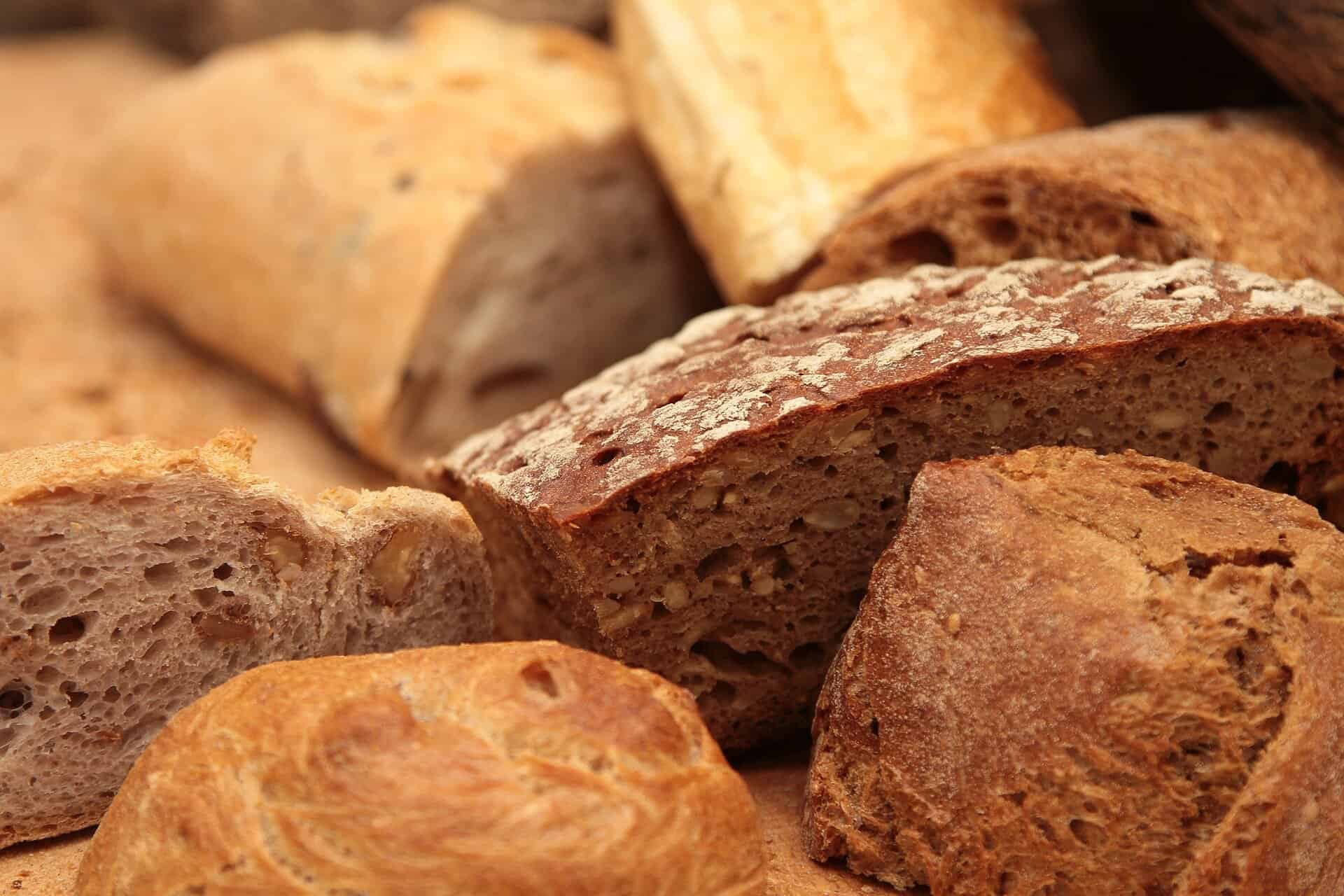Cutting out all bread is a popular, yet often misguided, tactic some dieters employ to quickly drop pounds. Eliminating one food group or one item, such as healthy bread, from your diet is often not sustainable and can have a rebound effect. In other words… then you overeat what you told yourself you could no longer have!
At Noom, we take the approach that changes need to be sustainable over a lifetime. Any food or beverage choice can be a part of your day as long as it fits into your budget. With breads and other grains, the Dietary Guidelines for Americans advises that healthy individuals consume at least half of their recommended daily grain intake in the form of whole grains. So, for example, if you eat 6 ounces of bread, pasta, rice, and/or other grain products in a given day, at least 3 of those ounces should be made from whole grains.
Whether it is a sandwich, morning toast, English muffin, or a bagel, bread is an easy, convenient, and popular way to fill up on whole grains. While this concept seems like a no-brainer, a trip to the grocery store often leaves consumers wondering which bread product is the healthiest kind to put in their shopping carts. It may take a little detective work, but it is possible to discover the healthiest bread option by honing in on a few key clues.
What is the healthiest type of bread for weight loss?
1. Select products with 100% on the front label
Look for phrases similar to “100% Whole Grain” or “100% Whole Wheat” written on the front of the package. A 100% whole grain means just that. All three parts of a grain – the bran, germ, and starchy endosperm – have been ground up and turned into flour used to make a bread product. Bread made from refined flour consists of just the starchy part of the grain, leaving out many cancer fighters, some natural fiber, and other health properties found in the bran and germ.
2. Examine the ingredients list
Flip over the package and read the fine print. By law, ingredients are listed by weight with the first ingredient making up the largest part of a product. Some examples to look for are “100% whole wheat flour,” “100% whole grain flour,” “whole wheat flour,” “whole grain flour” or “whole spelt flour,” etc. If additional flours are listed such as unbleached flour or wheat flour (minus the word “whole”), the product is not a 100% whole grain product. Key words are 100% or whole. Oats, oatmeal, wheat berries, and brown rice are also 100% whole grain ingredients.
Words that indicate a bread is NOT made of 100% whole grains:
If you see these words listed, the product is not 100% whole grain – enriched flour, pearled barley, degerminated, bran, or wheat germ. Enriched flour is refined flour with added b vitamins and iron. Semolina, wheat flour, durum wheat, organic flour, stoneground, and multigrain are all refined grain flours unless they are preceded by the word “whole” on the ingredient’s list.
3. Be choosy about additives
The shorter the ingredients list the better. A product can be made of 100% whole grains but also contain a lot of extra sweeteners and preservatives. Be aware that sugar has multiple names which can be spread out throughout an ingredients list, making a product appear to an uninformed consumer to contain less sugar. Some common names for sugar are corn syrup, high fructose corn syrup, molasses, fructose, dextrose, galactose, honey, cane sugar, coconut sugar and many more. Some recent goods news in the United States is that the category of “Added Sugar” will now be required on nutrition facts labels. This category indicates the amount of sugar that was added to a product in processing versus sugar that is naturally occurring in an item, such as the natural sugar in fruit or milk.
4. Look at the nutrition facts panel
One hundred percent whole grain bread generally contains more fiber and more protein per serving than standard white bread. This translates into keeping your blood sugar steady and leaving you with a greater sense of fullness. A typical 28 gram (g) or 1 ounce slice of 100% whole wheat bread contains about 70 calories, 0.5g fat, 12g carbohydrates, 2g added sugar, 2g fiber, 3g protein, and 100g sodium. Three grams of fiber per slice of bread is considered to be a good source of fiber. You’ll generally have to eat bread that comes sliced larger, such as 1.5 ounces or 42g, to meet this good source recommendation or have 2 slices of smaller slices of bread.
5. Don’t be fooled by color
Some manufacturers add molasses or caramel food coloring to refined white bread to make it appear to be wheat bread. Conversely, some types of wheat are naturally white in color and are used to manufacture 100% whole wheat white bread.
Real results with a personalized weight loss program
Take the quiz!

The healthiest breads to eat for weight loss
While this list is not exhaustive, here are some types of bread that may offer some advantageous properties when it comes to your health. If you’re looking to boost nutrition, reduce sodium, or pump your protein, your grocery store shelf has plenty of options.
1. The best whole grain sprouted bread for weight loss
Whole grain sprouted bread is considered by many to be one of the healthiest types of bread around. To make this type of bread, a whole grain is allowed to germinate or grow a little, prior to being turned into flour. This allows for the release of additional nutrients and less gluten compared to whole grain flour. One of the healthiest on the market is Ezekiel 4:9 Low Sodium Sprouted Whole Grain Bread. It has no added sugar or sodium and is found in the refrigerated section of the supermarket. Since breads are one of the top sources of high sodium foods in the American diet, this no sodium brand is an excellent option for those needing to monitor their intake, such as individuals with high blood pressure.
Nutrition facts: One slice (34g), 80 calories, 0.5g fat, 0mg sodium, 15g carbohydrates, 3g fiber, 0g sugar, 3g protein
2. The best whole wheat bread for weight loss
There are lots of options available for 100% whole grain bread. A shorter ingredient list absent of unfamiliar, complicated words is generally a quick way to determine what might be the best way to go. Ezekiel 4:9 Low Sodium Sprouted Whole Grain Bread mentioned above is an excellent choice for this category as well!
Another great choice is Dave’s Killer Bread 100% Whole Wheat Bread. Consumers will likely recognize all ingredients listed on the package such as organic whole wheat, cane sugar, and canola oil.
Nutrition facts: One slice (42g), 100 calories, 1.5g fat, 160mg sodium, 21g carbohydrates, 3g fiber, 4g sugar, 4g protein
3. The best thin-sliced bread for weight loss
If you’re looking to cut calories but still enjoy a good sandwich or bagel look for mini, skinny, or thin versions. While it still has 70 calories per slice,
Dave’s Killer Bread Thin-Sliced Organic 21 Whole Grains and Seeds is one of the most nutrient packed thinner sliced organic breads around.
Nutrition facts: 1 slice (28g), 70 calories, 0g fat, 105mg sodium, 13g carbohydrates, 2g fiber, 3g added sugar (total sugar), 3g protein
If you’re mainly focused on calories and like the visual of two pieces of bread for your sandwich, Pepperidge Farms Very Thin Sliced 100% Whole Wheat Bread is only about 40 calories per slice (15g). According to the package one serving is 3 slices. To help you compare, we’ve cut it down to two slices.
Nutrition facts: Two slices (30g), 73 calories, 1.3g fat, 119mg sodium, 14g carbohydrates, 2g fiber, 1.3g total sugar (added not listed), 3.3g protein
4. The best high-fiber bread for weight loss
Bread made from 100% whole grains contains the highest natural fiber. However, if you feel you don’t get enough each day, choosing a brand with added fiber is one way to easily up your intake. The Dietary Guidelines for Americans recommends 25 grams of fiber for adult women and 38 grams for adult men under the age of 50. Women and men older than 50 should have 21 and 30 daily grams, respectively. Fiber is important for digestive health and to ward off diseases such as diabetes, cardiovascular diseases, and some cancers. Eating fiber-rich foods can also provide a sense of long lasting fullness by helping to keep blood sugar levels steady. While typical healthy breads have about 2 grams of fiber per slice, Nature’s Own Life Double Fiber Wheat Bread has twice that amount and also is one of the lowest calorie breads around.
Nutrition facts: One slice (28g), 50 calories, 0.5g fat, 120mg sodium, 11g carbohydrates, 4g fiber, <1.0g total sugar (added), 3g protein
5. The best high-protein bread for weight loss
Similarly to adding additional fiber, protein-enhanced foods may provide an increased sense of fullness. Protein sources vary by brand. Adding a large volume of ground up nuts, seeds, and pulses is a natural way food manufacturers can pump up the protein content of any bread. Breads with the highest protein content also generally have ingredients that are similar to what is found in protein powders such as whey, casein, or soy. An example of this type of combination is P28 High Protein 100% Whole Wheat Bread.
Nutrition facts: One slice (47g), 130 calories, 3.5g fat, 220mg sodium, 12g carbohydrates, 2g fiber, 3.0g total sugar, 14g protein
6. The best gluten-free bread for weight loss
For those who cannot tolerate gluten for medical reasons, gluten free bread can be a viable substitute for bread made with wheat, rye, or barely. You are not likely to find many 100% whole grain gluten free breads on the market, however looking for a short ingredient list with common terms such as brown rice, corn, potato starch, tapioca flour, yeast, and sugar, is still a good practice to follow when trying to determine which brand to select.
Food for Life has a large selection of gluten free bread products. Their Gluten Free Original 3 Seed Bread is one of the healthiest options you can select as it has 3 grams of fiber per slice and no added sugar.
Nutrition facts: One slice (42g), 110 calories, 2g fat, 120mg sodium, 20g carbohydrates, 2g fiber, 1.0g total sugar, 2g protein
The Canyon Bakehouse brand is one of the few 100% whole grain gluten free breads on the market. It’s nutritional value is very close to typical whole grain bread.
Real results with a personalized weight loss program
Take the quiz!

Nutrition Breakdown: One slice (34g), 90 calories, 1.5g fat, 110mg sodium, 17g carbohydrates, 1g fiber, 2.0g total sugar (added), 2g protein
With so many different brands on the market, figuring out which bread is the best version for you can take an initial investment of time. However, it’s clear that discovering bread you love to eat and that will also help move the scale is well worth the effort in the long run!
For more helpful tips and tricks to improve your eating habits, kickstart your Noom trial today!



